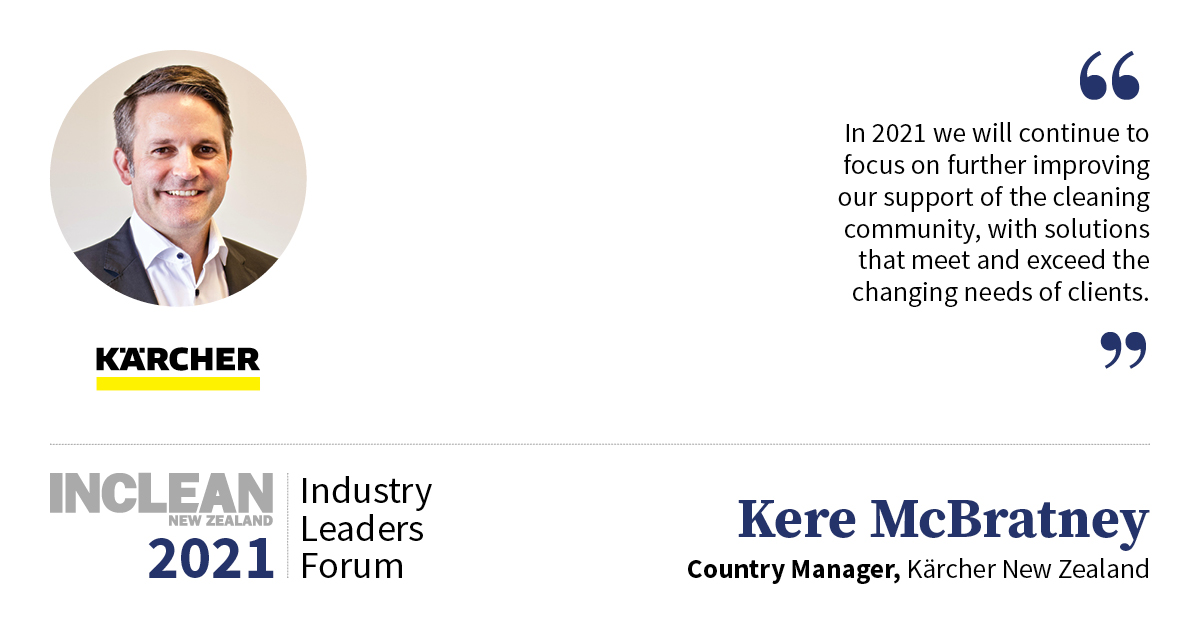
How was 2020 for Kärcher NZ? What were the highlights? What were the challenges?
2020 was a challenging year for Kärcher, like for most NZ businesses. Despite the disruption COVID brought, Kärcher finished the year with growth versus 2019 and with a healthier organisation – something we are very pleased with.
Challenges were in managing the immediate impact of the lockdown; in juggling the needs of our customers who continued operating as essential businesses, the health and well-being of the team and those with whom we work, and the impact on the organisation; along with the mid to long-term impacts – rapid changes in customer needs, forecasting to changing lead times and logistical considerations, working with the team to assist them in uncertain times.
How did Kärcher NZ adjust to the impact of the pandemic?
We tried as a team to ensure we kept the health and wellbeing of team members, customers, and clients as the first consideration. We have had, like most of the industry, to make changes under the duress of time and with a large amount of uncertainty.
This has meant challenging some of our own previously held views and what for some were almost conventional wisdoms. The team have handled the changes thrust upon them by circumstance very well – something I am immensely proud of.
Did you notice any changes in customer behaviour in 2020?
We have seen a few changes in customer behaviour during the course of 2020. From an initial, and very understandable reserved approach to making decisions by many on higher value acquisitions in the lockdown and the first months following, things have moved quickly to an increasing willingness of late to invest in the future as more confidence returns to the customer community.
Some customers showed an increased willingness to invest right from the start of the pandemic, whilst others have slowed investments to a trickle and will rightly wait until the return to what is for them “business as usual” before they invest again.
Additionally, we have seen significant changes in demand across categories, as customers seek previously available solutions to problems that did not exist until the onset of COVID.
We have tried to make sure we are bring the right solutions to the table to meet the changing needs of the market and individual customers – a one-size fits all approach is never a solution for the customer community, and even less so in 2020.
We have also worked to ensure we provide even more support in after-market service as we know that some traditional providers in this space have disappeared, but the customer needs remain.
What will be the immediate focus for Kärcher NZ in 2021?
In 2021 we will continue to focus on further improving our support of the cleaning community with relevant solutions that meet and exceed the changing needs of their clients.
Simon and the team have been working through several long-term initiatives which were implemented in 2020 that require more time to fully bed-down, so these remain a priority for 2021.
Kärcher reinvests 6 per cent of its global turnover back into research and development to ensure industry leading products are available for its customers.
We are looking forward to introducing new product solutions to the NZ market in 2021 that we believe increase the relevance of our offer relative to local needs.
What challenges and opportunities do you see for the industry over the next 12 months?
One clear challenge which is not unique to our industry, is the availability of products and raw materials.
The disruption to the international supply-chain is likely to continue for some time, and with this we will likely see ongoing pressure on product availability and freight rates, putting more pressure on historically low margin businesses.
A significant opportunity is addressing the productivity challenges both the industry and NZ has been grappling with for some time.
Increasing labour costs and the availability of labour will likely remain challenging moving forward, so solutions that address productivity will come to the fore in the coming months and years.
Looking at the future what do you see, as far as changes and adjustments, the industry must embrace?
The move to robotics and autonomous cleaning solutions is more pertinent now than ever before. However, it is also important to continue to focus on equipment which is simple to use and robust in operation whilst meeting price points which allow for investment to achieve maximum efficiencies from the available limited manual resources.
Additionally, how to integrate the ongoing concern/need to sanitise and disinfect as part of the normal cleaning regime will be a topic that remains for some time. The question is maybe what the new, optimised “normal” should look like, both in the face of the pandemic and post-COVID.
What is one issue the industry should urgently address in 2021?
Investment into training for the front-line staff. Training takes time and money, so it is easy to take the risk of underinvesting in this area. The fall-out from this underinvestment may be a high turnover of staff, reduced efficiencies, added costs in repairs or extra labour requirements.
Time is the most expensive resource that we all have so it is paramount that we spend the time wisely, investing in training for the staff to deliver more with less, ‘Buy right-buy once’. Training investments today support a long-term payback which continues to deliver benefits well into the future.
This article first appeared in the February issue of INCLEAN NZ magazine.
Read the original article here.
Comment below to have your say on this story.
If you have a news story or tip-off, get in touch at info@13.238.154.125.
Sign up to INCLEAN NZ’s newsletter.